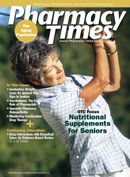Publication
Article
Pharmacy Times
From the Publisher: Today's Seniors: Aging Gracefully
Author(s):

Everywhere you look, the senior population is in the news from publications on improving brain health to comprehensive aging studies to reports on geriatric medication management. Here’s an amazing fact: two thirds of all people in the entire history of the world, who have lived to be 65 years old, are alive today, according to Dilip Jeste, MD, and Colin Depp, PhD, in their new book, “Successful Cognitive and Emotional Aging (American Psychiatric Publishing, Inc. 2009). The aging population, fueled by the sheer numbers of baby boomers and pre-boomers, is top of mind for health care providers—especially pharmacists who routinely counsels this group on medication management and critical issues of health and well-being.
As people age and medical conditions arise, more prescription drugs come into the picture. A recent national survey of more than 1000 people, aged 65 and older who use medications, revealed that 51% take at least 5 different prescription drugs regularly and 1 in 4 take between 10 and 19 pills each day. And the more medications, the more possibility of skipping doses or forgetting to take them. America’s seniors are caught in an economic bind as well, with 40% citing affordability as their top concern with regard to prescription medications. Pharmacists are on the front lines with this population group as they work to reduce costs, avoid drug interactions, and communicate vital health information on a daily basis to this important population group.
In this special Aging Population issue of Pharmacy Times, we bring you valuable tools to address those universal issues so critical to this growing patient pool. In our Rx Focus, we focus on how pharmacists can be instrumental in ensuring that combination drug therapy is used appropriately (see “Monitoring Combination Drug Therapy”). Our OTC Focus spells out how the senior population can best meet their nutritional needs in “Multivitatim/Multimineral Supplements: Meeting the Nutritional Needs of Older Patients”. The older population suffers disproportionally from weight loss, so “Involuntary Weight Loss—An Ignored Vital Sign in Seniors” provides important information on this topic. In counseling their older patients who take multiple prescriptions and use OTC products as well, pharmacists can utilize our Patient Education feature in this issue—“Must Haves for the Medicine Cabinet”—to guide them.
As always, Pharmacy Times provides free Continuing Education in each issue, along with a wealth of features and columns on important topics in health care today—be sure to look at “The Expanding Role of Pharmacists and Vaccination” (see page 74) to stay current in this area.
Thank you for Reading!








